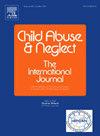埃塞俄比亚Gashena镇儿童性虐待的患病率及相关因素:基于学校的横断面分析
IF 3.4
2区 心理学
Q1 FAMILY STUDIES
引用次数: 0
摘要
儿童性虐待(CSA)涉及与儿童发生的任何形式的性行为,如性交、不适当的触摸或暴露于色情内容,以满足犯罪者的需求。它是全世界,特别是包括埃塞俄比亚在内的撒哈拉以南非洲的一个重大公共卫生问题。尽管人们对CSA普遍存在的认识有所提高,但对其在埃塞俄比亚女小学生中的影响的研究仍然有限。本研究旨在评估埃塞俄比亚Gashena镇女学生儿童性暴力的发生率,并确定相关因素。方法于2022年6月1日至6月30日在加什纳镇对422名女小学生进行横断面调查。本研究采用系统随机抽样的方法进行参与者选择,数据分析采用SPSS 25版本。为了检验变量之间的相关性,进行了逻辑回归,计算了优势比,并设置了p <的统计显著性;0.05.结果女小学生儿童性暴力总体发生率为16.4% (95% CI: 12.8 ~ 19.8)。宗教(AOR: 95% CI: 2.441(1.398-4.259))、种族(AOR: 95% CI: 0.238(0.121-0.467))、照顾者类型(AOR: 95% CI: 0.069(0.029-0.162))和照顾者收入(AOR: 95% CI: 3.083(1.576-6.026))是儿童性暴力的显著相关因素。结论本研究揭示了小学女生儿童性暴力发生率的惊人增长,凸显了社会日益关注的问题。该研究确定了与这一问题相关的几个关键因素,包括宗教、种族、照顾者类型和收入水平。本文章由计算机程序翻译,如有差异,请以英文原文为准。
Prevalence and associated factors of childhood sexual abuse in Gashena Town, Ethiopia: A school-based cross-sectional analysis
Background
Child sexual abuse (CSA) involves any form of sexual activity with a child, such as intercourse, inappropriate touching, or exposure to sexually explicit content, perpetrated for the offender's gratification. It is a major public health concern worldwide, especially in Sub-Saharan Africa, including Ethiopia. Although awareness of CSA's widespread occurrence has increased, there is still limited research on its effects among female primary school students Ethiopia. This study aims to evaluate the prevalence of childhood sexual violence and identify associated factors among female students in Gashena town, Ethiopia.
Method
A cross-sectional survey was carried out in Gashena town between June 1 and June 30, 2022, with 422 female primary school students participating. The study utilized systematic random sampling for participant selection, and data were analyzed using SPSS version 25. To examine associations between variables, logistic regression was conducted, with odds ratios calculated and statistical significance set at p < 0.05.
Result
The overall prevalence of childhood sexual violence among female primary school students was 16.4 % (95 % CI: 12.8–19.8). Religion (AOR: 95 % CI: 2.441 (1.398–4.259)), ethnicity (AOR: 95 % CI: 0.238 (0.121–0.467)), types of caregivers (AOR: 95 % CI: 0.069 (0.029–0.162)), and income of caregiver (AOR: 95 % CI: 3.083 (1.576–6.026)) were factors significantly associated with childhood sexual violence.
Conclusion
This study uncovered an alarming increase in the prevalence of childhood sexual violence among female primary school students, highlighting a growing concern within the community. The research identified several key factors linked to this issue, including religion, ethnicity, caregiver type, and income level.
求助全文
通过发布文献求助,成功后即可免费获取论文全文。
去求助
来源期刊

Child Abuse & Neglect
Multiple-
CiteScore
7.40
自引率
10.40%
发文量
397
期刊介绍:
Official Publication of the International Society for Prevention of Child Abuse and Neglect. Child Abuse & Neglect The International Journal, provides an international, multidisciplinary forum on all aspects of child abuse and neglect, with special emphasis on prevention and treatment; the scope extends further to all those aspects of life which either favor or hinder child development. While contributions will primarily be from the fields of psychology, psychiatry, social work, medicine, nursing, law enforcement, legislature, education, and anthropology, the Journal encourages the concerned lay individual and child-oriented advocate organizations to contribute.
 求助内容:
求助内容: 应助结果提醒方式:
应助结果提醒方式:


